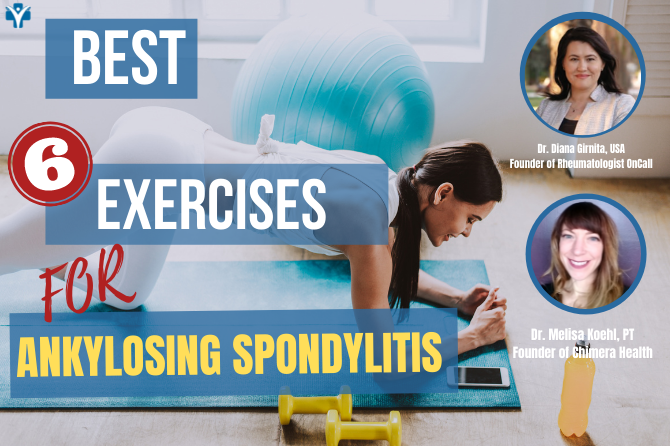SHARE
Exercise needs to be part of the treatment plan in patients with Ankylosing Spondylitis. This disease can be very disabling if not treated early and appropriately. It is an inflammatory arthritis of the spine that can cause difficulty getting out of bed, picking something up from the floor, or even walking. Often, my patients will notice that moving, like stretching or doing exercise in the mornings, will be very helpful. However, many of my patients wonder if exercise damages their joints.
In this article, Dr. Melissa Koehl and I discuss:
- What is Ankylosing Spondylitis, and how can it affect your spine?
- What is the role of exercise in treating Ankylosing Spondylitis?
- What are the types of exercises that we recommended?
What is Ankylosing Spondylitis, and how can it affect your spine?
Ankylosing spondylitis, or as we commonly abbreviate it as “AS,” can be a very disabling disease. It is an inflammatory arthritis of the spine that can sometimes affect the peripheral joints and other organs. Most of the time, Ankylosing spondylitis affects young adults, more frequently males than females.
Patients under 45 years old present to the doctor after many months of persistent back pain. This disease can affect different parts of the spine, from the neck, thoracic, and lumbar spine to the sacroiliac joints. Patients can also experience pain in the buttock area or alternating pain in the hips. Therefore, mornings and nights are challenging for patients with Ankylosing spondylitis.
Patients toss around in bed at night, and they sleep very poorly.
They have difficulties getting out of bed or even walking to the bathroom in the mornings. Moreover, the stiffness is prolonged and usually lasts more than 1 hour. However, patients notice that moving helps.
The more they move, the better it is.
The stiffness comes back when they sit for prolonged periods, for example, working at the desk or even watching a movie.
If you want to learn more about the most common symptoms of Ankylosing spondylitis, read this blog on my website or watch my Youtube video.
What is the role of exercise in treating AS?
I believe in treating the whole person and not only the disease. In my practice, I introduce patients to integrative medicine at their diagnosis. In patients with Ankylosing Spondylitis, exercise is an essential part of treatment.
WHY?
Exercise helps patients physically and mentally.
Yes, Exercise will improve your pain level, mobility, strength, balance, and flexibility.
Patients that exercise regularly also have other health benefits like decreasing cardiovascular risk, regulating blood pressure, increasing good cholesterol (HDL), and maintaining good bone density.
Regular exercise helps maintain a proper weight, which allows for your arthritis, too, as when you put more weight on your joints, they deteriorate faster.
What are the types of exercises recommended?
There are four main types of exercises that I recommend to my patients:

1. Range of Motion or Stretching
This exercise will improve flexibility and reduce stiffness, swelling, and pain. They will minimize the risk of bone fusion from ongoing inflammation. Do these exercises daily before any activity to “warm-up” your joints.
2. Aerobic or Cardiovascular
CARDIO exercises will help improve your heart and lung function. In people with AS affecting the thoracic spine, breathing becomes difficult, and aerobic exercises will help your breathing, endurance, and pain.
3. Strengthening
These exercises will help you improve your “core muscles”, which support your spine, maintain a good posture, and help decrease your back pain.
4. Balance
BALANCE Exercises are appropriate for less active people to reduce their risk of falling. Unfortunately, most patients with long-term AS develop osteoporosis, so falling could lead to fractures, leading to many other complications from blood clots to chronic pain and poor quality of life.
When diagnosed with AS or inflammatory arthritis, I highly recommend working with an experienced physical therapist who will incorporate all these exercises and adjust them to your body’s needs.
The best exercises for Ankylosing Spondylitis
Now, let me introduce you to Dr. Melissa Koehl: she is a Physical Therapist, Board Certified Orthopedic Clinical Specialist, Certified Orthopedic Manual Therapist, and Pilates Instructor. Dr. Koehl has 20 years of experience treating patients with complex orthopedic issues, including arthritis, chronic pain, fibromyalgia, and more.
In the video above, Melissa will teach you six exercises you can practice at home to improve your pain, joint mobility, and strength. Take some time to see and try these exercises. Start slow and progress to the level of your comfort.
If you have developed back pain and are concerned about Ankylosing Spondylitis, you can consult Rheumatologist OnCall, a telemedicine practice that can evaluate from the comfort of your home.
Rheumatologist OnCall broadens access to rheumatology, breaking geographical barriers and being able to help patients in multiple states in the United States.
Dr. Diana Girnita integrates the most advanced therapies in rheumatology with a holistic approach that will include lifestyle interventions. Nutrition, stress management, mindfulness, and exercise are essential in achieving lower disease activity and thriving with arthritis. You can contact us if you want a consultation or even a second opinion.
We are happy to help you!
Contributors to this article:
Diana Girnita and Melissa Koehl, PT














